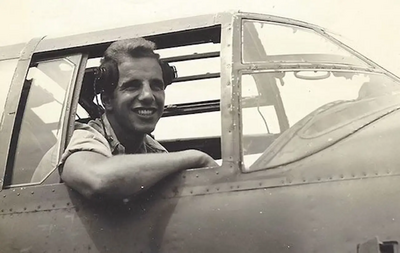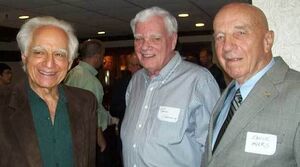 | |
| Charles E. Myers | |
|---|---|
| Allegiance | United States |
| Part of a series on the |
| Fighter Mafia |
|---|
Charles E. ("Chuck") Myers Jr. (March 21, 1925 – May 9, 2016) was an aviation pioneer and an early member of the "Fighter Mafia" inside the Pentagon.[1] He served as the Director for Air Warfare in the Office of the Secretary of Defense between 1973-78 during which time he launched Project Harvey which later became known as the “stealth” program.[2]
Early Life
Myers was born in the vicinity of Langley Field in Hampton, Virginia and raised in Philipsburg, New Jersey. In his youth, Myers displayed a remarkable talent in athletic pursuits, and harbored a deep-seated yearning to take to the skies. During his final year of high school he guided his team, the "Gridders," as quarterback, culminating in an undefeated season.
Army Air Force (World War II)
At the tender age of 18, Chuck Myers embarked on his military journey, joining the ranks of the Army Air Forces during the tempestuous years of World War II. Endowed with a rare talent for aviation, he took to the skies as a B-25 pilot, carving a path of distinction. He was assigned to the 345th Bomb Group, as part of the Fifth Air Force. At the helm of the low-flying aircraft, he flew daring attack missions to vanquish Japanese shipping in the vast expanses of the Pacific theater.
Following the end of the war, Myers left the Army Air Forces in October 1945 to pursue academics, enrolling in Lafayette College to study engineering. In the midst of his academic pursuits he continued to ply the skies with an Air Force reserve unit stationed in Newark, New Jersey. Myers emerged from college in 1949, equipped with a degree in mechanical engineering.
After obtaining obtaining his degree, Myers viewed the prospect of a mundane engineering career with disdain. Despite his vast experience as a pilot, he had to learn how to take to the skies once again, this time, in the Navy way. He was soon qualified as a Navy pilot, serving aboard the USS Bon Homme Richard, flying F9F Panther jets during the Korean War. Myers flew in missions designed to interdict supply routes.
Lieutenant Myers' performance during the war was exceptional, earning him the honor of being selected to attend the prestigious US Navy Test Pilot School, from which he graduated in 1954. Among his classmates were the likes of John Glenn, the future astronaut and U.S. Senator, and James Stockdale, the future Medal of Honor recipient and vice presidential candidate. After graduation, Myers spent two years conducting test flights for the Navy before joining the Convair aircraft company as a civilian test pilot.
Civilian Life
Test Pilot
At Convair, he initially worked on the XYF-1 "Pogo" aircraft, a propeller-driven experimental plane designed for vertical takeoff and landing. Although the project was eventually cancelled, Myers continued on, moving to Edwards Air Force Base as part of the company's flight test team, where he worked on the F-106 Delta Dart aircraft. Myers' thirst for pushing boundaries and testing limits would lead him to set the world speed record in 1960, pushing the F-106 to a speed of 1,544 miles per hour. This shattered the previous record set by a Soviet pilot. Despite this, the official record holder would be Air Force Major Joe Rogers. While the honor eluded him, Myers' contribution to the achievement was not entirely overlooked, as he received a gold watch to commemorate his remarkable feat.
Society of Experimental Test Pilots
Myers' had lost friends in crashes, and he knew that sharing knowledge and lessons learned was critical to keeping the pilots safe. In order to facilitate this, Myers and his fellow pilots founded the Society of Experimental Test Pilots. The organization brought together some of the most skilled and daring pilots from around the world, all united by a common goal: to push the boundaries of aviation. Chuck Myers was eventually elected as the president of this organization.
Aerocounsel, Inc.
Following his time at Edwards Air Force Base, Myers founded Aerocounsel, Inc. He envisioned it as a "mini-think tank" that would cater to the aerospace community. As an expert in aviation and a skilled strategist, he quickly gained recognition for his consulting work with the biggest names in the industry, including major aerospace companies and government agencies such as NASA, the Air Force, the Navy, and the Federal Aviation Administration.
Tactical Fighter Experimental
In the early 1960s, the Department of Defense had mandated the development of a new plane, the Tactical Fighter Experimental, or "TFX," with the objective of performing multiple missions. Lockheed submitted a proposal for a plane that weighed approximately 80,000 pounds and was designed to perform five missions: air superiority, close air support, all-weather attack, nuclear attack, and interception. However, Myers saw the flaw in the idea of multi-role aircraft. He knew that the compromises necessary to fulfill all the missions would render the plane unable to perform any of them effectively.
Myers spent the next several years advocating for separate airframes to optimize combat effectiveness for different missions. He found allies in John Boyd and Tom Christie, who were pioneering the "Energy-Maneuverability (EM)" theory at Eglin Air Force Base in Florida. With EM charts, designers could now accurately assess how an aircraft performs in flight and compare performance between different planes. Myers recognized that the EM charts would prove that the TFX would be outmaneuvered by the latest Soviet designs. The TFX program produced the F-111, a large, multi-role fighter plane that is now widely regarded as a design failure .
Director for Air Warfare in the Office of the Secretary of Defense
Myers made a significant impact on the development of tactical aircraft in the 1970s. Appointed as the Director for Air Warfare in the Office of the Secretary of Defense in 1973, he oversaw the research and development of several tactical aircraft in development. Myers recognized the need for mission-specific aircraft and successfully advocated for their development.
According to Pierre Sprey, “From [WWII] on, Chuck always felt that the fighting guy on the ground was getting screwed and he was seeing the fighter pilots were being screwed from bad airplanes in the air. It was solidarity with the pilots and grunts—it was that simple."[3]
Myers' efforts resulted in the successful development of several aircraft, including the F-15, which was designed to achieve air superiority. However, Myers knew that there was room for improvement and helped bring together a group of like-minded individuals, including John Boyd, Everest Riccioni, and Pierre Sprey, to design even better fighter planes.
Their collaboration resulted in the Lightweight Fighter program, which produced the F-16 and F-18. These aircraft were designed to be agile, versatile, and cost-effective, and they proved to be a significant improvement over previous designs. Myers' contributions to the development of these aircraft were invaluable, and he played a vital role in shaping the future of tactical aviation.
Later Career
Personal Life
Death
Awards and decorations
- ↑ Grazier, Dan. "POGO Remembers Chuck Myers, "Fighter Mafia" Veteran". www.POGO.org. Retrieved 28 June 2016
- ↑ Richards, Chet (12 May 2016). "Life of Chuck Myers". slightlyeastofnew.com/. Retrieved 28 June 2016.
- ↑ Kelley Beaucar Vlahos, "The Unsung Hero of American Air Power," American Conservative, Dec 1, 2016
